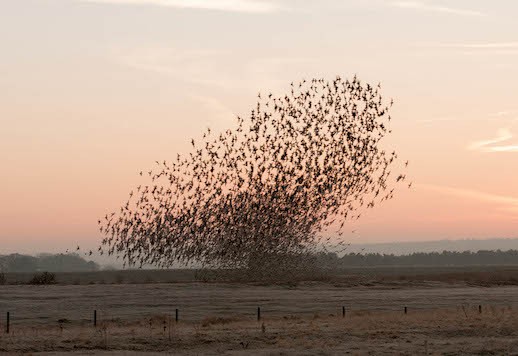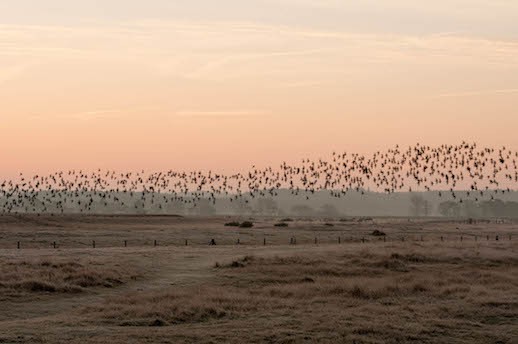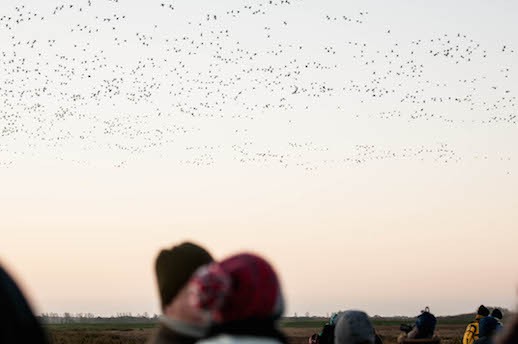Words and pictures Danny Adcock
I live literally ten minutes from RSPB Snettisham; it’s the reserve often featured on either Autumn, Winter or Springwatch as the location of the ‘wader spectacular’, and the roosting site – according to my village magazine – of at the moment twenty-five-thousand pink footed geese. I don’t consider myself a birdwatcher in that I don’t go out looking specifically for birds though I do always have a pair of binoculars with me; first and foremost I’m an angler, and it is in this capacity that I get the opportunity to see many different birds. I think it was Isaac Walton who said “Study to be quiet” and it is truly amazing how close to wildlife you can get if you just sit and let it come to you. However, having seen it on the T.V. again the other night I decided it was time I got my backside out of bed a couple of hours before dawn and down to Snettisham to witness it for myself.
On the highest spring tides, particularly those that occur an hour or two after dawn, the tens of thousands of waders – knot, dunlin, and godwit amongst others – which have been spending the night far out on the mudflats of the Wash get a rather rude awakening as the tide comes in. The Wash is notoriously shallow, which is one of the characteristics that make it such a special place, and for the last hour of the flood tide the sea creeps landward across the mudflats with the same inevitability that also brings the dawn. The dawn this morning brings a pink blush up a swathe of cloud rearing up in the South like a wave. The rest of the sky is clear, and ice hoars every blade of grass like flakes of frosted breakfast cereal.
The car park was already full when I arrived even though it was still dark. Walking boots, wellies, hats and gloves are pulled on and we follow, single-file, the narrow path behind one of the saline lagoons that are between us and the seawall, and the row of holiday cottages on top of it, some a little ramshackle looking in the daylight of later. After fifteen minutes or so we climb a bank and see the Wash itself. The dawn is breaking slowly, but the sun itself is still below the horizon to my left.
Far out on the flats, through the dim light, I can see the pink footed geese. From this distance they’re visible as long, dark masses of birds stretched across the flats like lines of indistinguishable handwriting. What is clearer though is the sound: goose talk. There’s an excited note to the twenty-five-thousand-odd pink footed geese that are chattering away to each other, and it genuinely sounds as though they’re having a bit of a chinwag, a bit of a gossip about the coming day; who’s going where and with who; who’s wearing what; like a group of schoolchildren at a bus stop. And then, while I’m still walking to the best view point, right in the very South-East corner of the Wash, the babble rises to a clamour like simmering water coming suddenly to the boil and they’re up; up and flying. A huge morass of black leaps from the mudflats in concert, like an orchestra standing spontaneously for applause, and I wonder which individual bird actually sparked the chain reaction that is now spreading skyward. They stream towards us, gaining altitude, and forming themselves into the characteristic v-shape skeins. As they pass overhead their talk settles down into a two-tone squeal designed to keep in touch with the flock, but it’s still an awesome sound and sight as countless thousands of them head inland. For a few minutes they’re visible as long trails of letters across the sky, fading to a blank page as they pass beyond view.
There are a couple of hundred people already spread along the shoreline, binoculars, scopes and lenses all focused intently toward the still-incoming tide that is being urged on by the strengthening onshore wind. There are still many geese left out there, and now and then a swirl of waders lift off, gather themselves together and with a rush of wings a long, smokey cylinder of birds swoosh low over our heads, and disappear below the lip of the lagoon that is now behind us as we look out across the Wash.
Another huge group of geese lift off to oohs and ahs from the crowd now, and follow their predecessors to the feeding grounds inland. Before us the tide has reached the outlying salt marsh and there are now no mudflats left. There is now very little option for the remaining waders but to fly. At first they are just a huge collection of birds in roughly the same vicinity, but suddenly they’re transformed into a single, swirling symphony on the clouds, as elaborate as any aria, as beautiful as any adagio, conducted back and forth across the sky; they rise and fall like notes from the strings, then rise again in a crescendo flashing white as the just-risen sun catches them. More and more pour themselves into the lagoon behind. At one point something spooks those that are already roosting on the lagoon’s banks and islands, and the sound of their wings as they take flight is like the rush of blood forced from a pulsing heart.
The sun is blazing as I begin the walk back to the car park but the frost still has a hold and a golden haze, backlit from the early rays of the sun, lies across the countryside to Sandringham and Wolferton. This Wash landscape is not mountainous; it’s not spectacular in the way the Lake District or the Highlands is, but it is just as significant to those of us who live here, and those who travel miles to see the geese and waders that are synonymous with it. There are many things in the world that everyone should see once in their lives, and there are many people in the world who will never see any of those things. This little corner of Norfolk contains a wonder of nature, and it is my heartfelt recommendation that you get your backside out of bed and down there if you ever get the opportunity.


